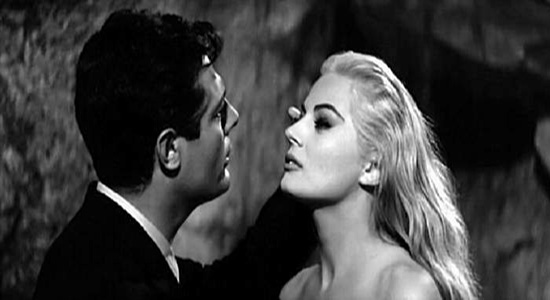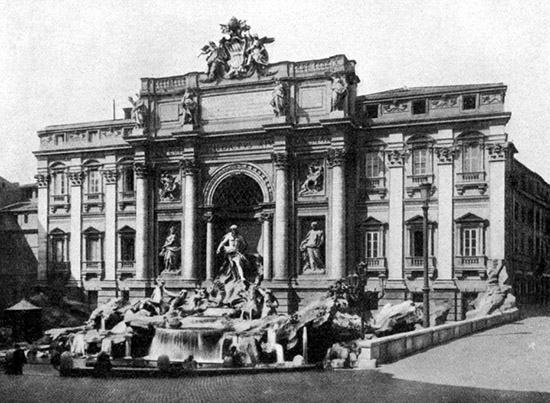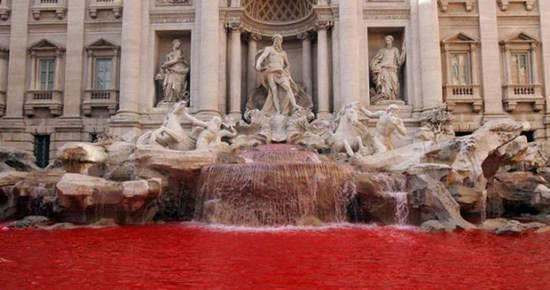Among the most famous films in the history of cinema is “La dolce vita“, directed by Federico Fellini in 1960. Anyone who has seen this Italian masterpiece, will certainly remember the film’s most famous scene: the sequence in which the journalist Marcello Rubini, the film’s main character, follows the famous actress Sylvia, played by Anita Ekberg, along the streets of Rome, until the fascinating diva plunges into the waters of a fountain in the city’s centre, the Trevi fountain. Here Marcello, played by Marcello Mastroianni, finally declares his love to the woman and, in exchange, gaining only a punch from her boyfriend. But what wouldn’t one do for love! The film won the Palme d’Or at the thirteenth Cannes Film Festival as well as an Academy Award for best costume design. Certainly, the marvellous Baroque fountain gave a great contribution to this success with a scenic setting that can rarely be found in other film sequences.

The Trevi fountain, a site where you find yourself after walking through the old streets of the city centre and where you maybe even throw in a coin to make a wish, is visited every year by thousands of people. It owes its origin to the late Baroque age. This monument is an example of sculptural triumph, of dramatic and symbolic expression. In order to solve a logistical problem due to difference in level between the two sides of the square, the architect Nicola Salvi designed a splendid staircase. The dominant theme of the scene is a rocky cliff, located in the lower side of the Palazzo Poli. Very beautiful is the niche that houses the statue of Oceanus driving a chariot with winged horses and tritons. To support the upper prospect there are four Corinthian columns with allegorical statues such as the Abundance of fruit, the Fertility of the fields, the Wealth of autumn and the Amenity of the gardens. Here, between the two main statues in the centre, was placed the coat of arms of Clemente XII and a commemorative inscription.
The well structured complex entirely made of travertine, hosts a variety of decorative plants and animals which, along with the flowing water, gives life to one of world’s most unique works of art.
Several Italian artists have contributed to its realization, from Maini to Pincellotti, to Bracci to Della Valle, all coordinated by the architect Salvi. Water plays the leading role both in the aspect of the perceptive impact, given by the actual motion of the water, and in the matter of the composition. It involves a series of metaphors and symbols that allude to the sea and its creatures.
This fountain dominates undisputed the Piazza of Trevi, which in fact owes its name to the “trivium” which flows into the Piazza of the Crociferi. The fountain is part of the Vergine aqueduct, an ancient Roman aqueduct dating from the Augustan age. Pope Nicholas V initiated an operation of reclamation of this aqueduct, which was particularly important for the population of Rome, since it allowed them to use the water of the Tiber.

This symbol of the city of Rome and of its Dolce vita has been a source of inspiration for the film industry, which captured by the beauty of the Trevi fountain, used its environment and its image on several occasions. Among the most important examples we find: in 1954 Three coins in the fountain, directed by Jean Negulesco, in 1961 Tototruffa 62 by Camillo Mastrocinque and Fontana di Trevi, directed by Carlo Campogalliani.
This masterpiece of Baroque art continues to be an important symbol within the cultural and social history of contemporary art. How can we forget the artistic initiative dated a few years back, which saw this monument as the main element of a performing interaction? On October 19th, 2007 Graziano Cecchini, a very active Italian contemporary artist, dyed the waters of the Trevi Fountain in red, recreating a new “view” of this Roman corner. Doubtlessly, the Trevi fountain could tell us many stories if only its waters could talk.



